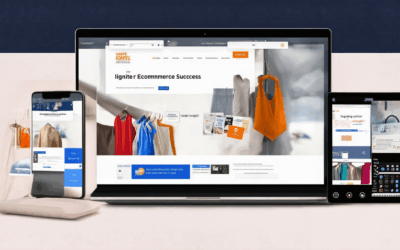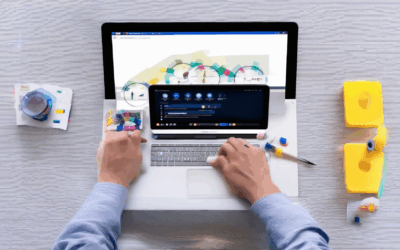In the ever-evolving digital landscape of 2024, web design remains a cornerstone of business growth and user experience. As technology advances, so do the demands for skilled web designers who can craft visually appealing, functional, and responsive websites. Whether you’re a seasoned professional looking to refine your skills or a newcomer eager to break into the field, mastering web design tutorials has never been more accessible or essential. This year, the demand for comprehensive web design resources continues to rise, offering diverse learning opportunities from free tutorials to advanced courses. With the right guidance, anyone can navigate the complexities of web design, regardless of prior experience or age. From understanding web design requirements to exploring the best tools and platforms, this guide will walk you through everything you need to know to excel in web design in 2024. Stay tuned to discover how you can ignite your future in this dynamic field.
Key Takeaways
- Master foundational skills in HTML, CSS, and JavaScript in 1-3 months.
- Extend your learning with UI/UX design principles, adding 1-2 months.
- Deepen expertise with front-end frameworks, extending timelines by 1-2 months.
- Build projects monthly to enhance learning and application.
- Leverage resources like 119 Web Design for structured guidance.
- Adjust dedication level to influence learning duration.
- Embrace continuous learning to stay ahead in the evolving field.
- Overcome age barriers and thrive in web development.
- Engage with supportive communities for better learning outcomes.

How to Create a Website for Beginners in 2024
Creating a website in 2024 is more accessible than ever, thanks to user-friendly platforms and tools. Below is a step-by-step guide tailored for beginners:
Step 1: Choose Your Platform
Decide which platform to use for building your website. Popular options include:
- WordPress : Ideal for those who want flexibility and control, especially with its vast plugin library.
- Wix : Known for its drag-and-drop interface and extensive template selection.
- Squarespace : Offers a sleek design and robust e-commerce features.
- Webflow : Great for designers and developers seeking advanced customization.
Step 2: Select Hosting
Once you’ve chosen your platform, select a hosting provider. Consider factors like:
- Cost : Shared hosting is often sufficient for personal or small sites, while VPS hosting offers more resources.
- Features : Look for plans that include SSD storage, free domains, and unlimited bandwidth.
- Support : Opt for providers with reliable customer support and comprehensive documentation.
Step 3: Design Your Site
Start by designing your site’s layout. Use templates provided by your platform or customize them to reflect your brand identity. Key tools include:
- Template Customization : Modify colors, fonts, and layouts to match your vision.
- Hiring a Designer : If you lack design skills, consider hiring a professional to create a custom design.
Step 4: Create Content
Develop high-quality content that aligns with your site’s purpose. Use the following tools to streamline the process:
- Content Creation Software : Write content using tools like Grammarly for proofreading and Canva for creating visuals.
- Organize Content : Structure your content with clear headings, subheadings, and paragraphs for better readability.
Step 5: Set Up Your Website
Install the necessary software and set up your site. This may involve registering a domain name and activating your hosting account. Key considerations include:
- Domain Registration : Choose a unique domain name and register it through a reputable registrar like Namecheap or GoDaddy.
- Platform Installation : Install WordPress, Wix, or other platforms based on your choice.
Step 6: Implement Security Measures
Protect your website from cyber threats by implementing the following measures:
- Password Protection : Use strong, unique passwords and enable two-factor authentication.
- Regular Updates : Keep your site updated to patch vulnerabilities and enhance security.
- SSL Certificate : Enable HTTPS to secure data transmission and build user trust.
Step 7: Analyze and Optimize Traffic
After launching your site, monitor its performance and optimize for better results. Use analytics tools like Google Analytics to track:
- Traffic Sources : Identify where your visitors are coming from and adjust your marketing strategies accordingly.
- Bounce Rate : Reduce bounce rates by improving content quality and user experience.
- SEO Performance : Optimize your content for search engines by incorporating relevant keywords and meta tags.
Step 8: Monetize Your Site
If applicable, explore monetization strategies such as:
- Display Ads : Partner with ad networks like Google AdSense to earn revenue from your content.
- Affiliate Marketing : Promote products and services and earn commissions through affiliate programs.
Step 9: Stay Updated and Engaged
Continuous learning is essential in the ever-evolving world of web development. Follow these tips to stay ahead:
- Subscribe to Blogs : Stay informed about the latest trends and best practices via industry blogs.
- Join Communities : Participate in forums and groups to network with other creators and learn from their experiences.
Step 10: Test Your Website
Before officially launching, conduct thorough testing to ensure your site functions correctly across all devices and browsers. Key aspects to check include:
- Responsive Design : Ensure your site looks good and works seamlessly on mobile devices.
- Functionality : Test all interactive elements, forms, and navigation menus for optimal performance.
By following these steps, you’ll be well-equipped to create a professional, functional website in 2024. Remember to continuously update and improve your site to meet the needs of your audience and stay competitive in the digital space.
The Future of Web Design
The future of web design is bright and full of opportunities, driven by technological advancements and evolving user needs. Here are key trends and predictions shaping the field:
- AI Integration : Artificial intelligence is revolutionizing web design by automating tasks like layout optimization, color scheme suggestions, and content creation. Tools like AI-powered design generators are making web design more efficient and accessible to non-professionals.
- Voice-Activated Interfaces : With the rise of smart devices, voice-activated web interfaces are becoming mainstream. Designers will need to focus on creating intuitive voice-driven experiences, ensuring that users can interact with websites naturally.
- Augmented Reality (AR) and Virtual Reality (VR) : AR and VR are transforming how products and services are visualized online. Web designers will play a crucial role in creating immersive experiences that bridge the gap between virtual and physical worlds.
- Progressive Web Apps (PWAs) : PWAs are expected to dominate the web landscape due to their ability to work offline, load quickly, and provide native app-like experiences. Designers will need to optimize their work for cross-platform compatibility and performance.
- Accessibility and Inclusivity : As the demand for inclusive design grows, web designers will focus on creating interfaces that cater to people with disabilities. This includes better screen reader support, keyboard navigation, and high-contrast modes.
- Sustainability in Design : There is a growing emphasis on sustainable web design practices. Designers are adopting energy-efficient workflows, reducing carbon footprints, and promoting eco-friendly user behaviors through their work.
- Ethical Design : Ethical considerations are becoming integral to web design. Designers are increasingly aware of privacy concerns, data usage, and the impact of their work on society. Ethical frameworks are guiding decisions around data collection, user manipulation, and content distribution.
- Cross-Browser Compatibility : With the rise of new browsers and updated versions of existing ones, ensuring cross-browser compatibility remains critical. Designers will need to adopt responsive design principles and testing methodologies to accommodate diverse user environments.
- User-Centric Design : Personalization and customization will continue to shape web design. Users expect tailored experiences, and designers are leveraging data analytics to deliver content that aligns with individual preferences and behavior patterns.
- Continuous Learning and Adaptation : The rapid pace of change in technology requires web designers to stay adaptable. Continuous learning, experimentation, and collaboration with developers will be essential to keep up with emerging trends and tools.
Web design is evolving rapidly, offering endless possibilities for innovation. By embracing emerging technologies, prioritizing user needs, and committing to ethical practices, web designers will continue to play a pivotal role in shaping the future of the internet.

How to Teach Yourself Web Design
Learning web design independently is achievable with the right approach and resources. Here’s a structured guide to help you get started:
- Start with Basics: Begin by mastering HTML and CSS. These are foundational languages that every web designer needs to know. Free resources like W3Schools and MDN Web Docs offer comprehensive tutorials tailored for beginners.
- Engage with Visual Learning: Consider watching educational YouTube channels such as FreeCodeCamp or TechCanTutor . Video content often provides clearer explanations and visual examples, aiding better comprehension.
- Utilize Frameworks and Tools: Once comfortable with HTML and CSS, explore frameworks like Bootstrap or WordPress to streamline your workflow. These tools offer pre-designed components that accelerate the development process.
- Build Projects Incrementally: Start small by creating a personal portfolio website. Platforms like GitHub allow you to host your projects and track your progress. Consider collaborating with friends or family to design websites for them, providing real-world experience.
- Join Online Communities: Engage with supportive communities on Reddit or Stack Overflow
- Stay Consistent and Motivated: Establish a daily routine dedicated to learning and project work. Track your progress through journals or online trackers to maintain motivation and accountability. Celebrate milestones to stay encouraged.
- Evaluate Your Tools: Use efficient IDEs like Visual Studio Code for a smooth coding experience. This tool is free and supports various extensions, enhancing your workflow with features like auto-completion and debugging.
By following these steps, you can systematically enhance your web design skills independently. Dedication and consistent practice are key to achieving your goals in this dynamic field.

How Many Months Can I Learn Web Design?
Learning web design involves several stages, each requiring a different level of dedication. Generally, it can take between three to six months to gain proficiency, depending on your commitment and prior knowledge.
Key Considerations:
- Basic Skills : Mastering HTML, CSS, and JavaScript typically takes around 1-3 months . These are foundational tools for web design and development.
- Design Principles : Understanding UI/UX design, color theory, typography, and layout can take another 1-2 months , bringing the total to approximately 4-5 months .
- Front-End Development : Adding JavaScript, React, or Vue.js can extend the timeline by another 1-2 months , reaching a total of 5-6 months .
- Project Building : Constructing real-world projects enhances learning. Aim to complete at least one project every month, which can vary in complexity.
- Resources and Support : Utilizing platforms like 119 Web Design can provide structured guidance, potentially shortening the learning curve.
- Dedication Level : Full-time dedication can reduce the timeline to 3-4 months , while part-time learning may extend it to 6+ months .
Conclusion:
While the initial estimate is three to six months, individual circumstances and goals will influence the exact duration. Consistency, practice, and seeking community support can help you achieve your objectives efficiently.
Is 30 Too Old to Learn Web Development?
No, 30 is not too old to learn web development. In fact, web development is a field that values diverse experiences and lifelong learning, making it an excellent choice for individuals of all ages.
1. Learning Speed and Adaptability
- Web development requires constant learning due to evolving technologies. At 30, you bring valuable life experience and a mature approach to problem-solving, which can accelerate your learning process.
- Online resources, tutorials, and courses are widely available, allowing you to learn at your own pace. Platforms like Codecademy and Udemy offer flexible learning options.
2. Career Flexibility
- Web development offers a broad spectrum of career paths, from front-end development to full-stack engineering. There’s no age limit on pursuing roles like Senior Developer or Lead Engineer .
- Many companies value experienced professionals who can bring unique perspectives to projects, making it easier to transition into tech roles later in life.
3. Community and Support
- Joining online communities like Stack Overflow or HashNode provides invaluable support and networking opportunities.
- Local meetups and coding groups can connect you with peers who share your passion for web development, offering mentorship and collaborative learning opportunities.
4. Continuous Learning Opportunities
- Web development is constantly evolving, with new frameworks, libraries, and tools emerging regularly. This dynamic environment encourages ongoing learning and professional growth.
- Participating in hackathons, attending conferences, and staying active in developer communities helps keep your skills sharp and connected to the industry.
Conclusion
Your age is not a limitation. With dedication, curiosity, and a willingness to adapt, you can successfully learn web development and embark on a fulfilling career in the field.

How Long Does It Take to Teach Yourself Web Design?
Learning web design as a self-taught individual can vary significantly based on your prior experience, dedication, and the resources you utilize. Here’s a breakdown of what to expect:
- Basic Skills (HTML & CSS): If you’re starting with no prior experience, you can grasp the fundamentals of HTML and CSS in 3–6 months . This involves learning how to structure web pages, apply basic styling, and understand layout principles.
- Intermediate Skills (JavaScript & Front-End Frameworks): Building on the basics, it can take another 6–12 months to master JavaScript, CSS preprocessors like Sass, and frameworks such as React or Vue.js.
- Advanced Skills (UI/UX Design): Delving into UI/UX design and user experience principles can extend the learning process by another 12–24 months , depending on your interest in design theory and tools like Figma or Adobe XD.
Key Factors Influencing Learning Time:
- Daily Commitment: Dedicate 1–2 hours daily to focused learning and projects to stay on track.
- Resource Availability: Utilize free online resources like FreeCodeCamp , Codecademy , and 119WebDesign to accelerate your progress.
- Community Support: Engage with forums like Stack Overflow or Reddit communities to seek advice and share experiences.
Conclusion:
Teaching yourself web design is achievable with consistent effort and the right resources. Expect to invest 3+ months for foundational skills and up to 2 years to become proficient in advanced areas. Stay committed, experiment regularly, and leverage online communities to enhance your learning journey.




0 Comments